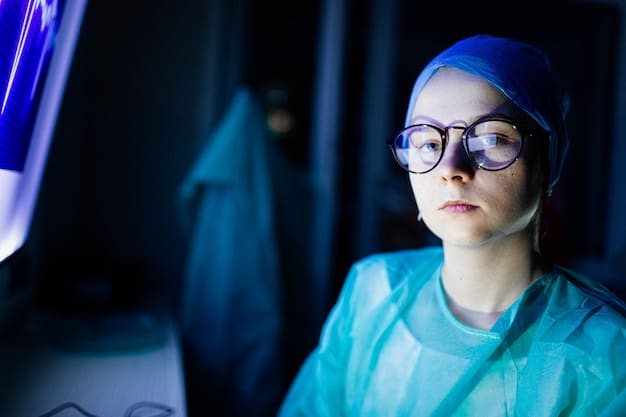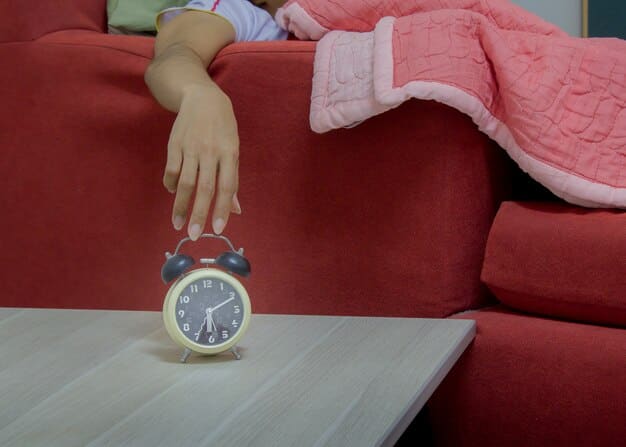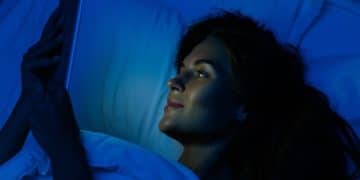Blue Light’s Impact on Sleep: Solutions for US Night Shift Workers

Night shift workers in the US face unique challenges from blue light exposure, significantly disrupting their circadian rhythms and sleep quality, necessitating practical solutions like light filtering and strategic scheduling to mitigate health risks and improve well-being.
Working night shifts in the US presents unique challenges, especially concerning exposure to artificial light. Understanding the impact of blue light on sleep: practical solutions for US night shift workers is crucial for maintaining health and well-being in a demanding environment.
understanding blue light and its effects on sleep
Blue light, a segment of the visible light spectrum, is naturally abundant during the daytime. It plays a vital role in regulating our circadian rhythm, signaling to our brains that it’s time to be awake and alert. For most people, this natural exposure helps maintain a healthy sleep-wake cycle. However, modern life has introduced new sources of blue light, particularly from electronic devices and LED lighting, which are omnipresent in workplaces, especially during night shifts.
The human eye has specialized photoreceptors, known as intrinsically photosensitive retinal ganglion cells (ipRGCs), that are most sensitive to blue wavelengths. These cells transmit signals directly to the suprachiasmatic nucleus (SCN) in the brain, our body’s master clock. When blue light hits these cells, it suppresses melatonin production, the hormone essential for promoting sleep, and boosts alertness. This mechanism is perfectly adapted for daylight, but becomes problematic when experienced during natural darkness.
For US night shift workers, exposure to this stimulating light during their “day” (which is night for the general population) can severely confuse the body’s internal clock. Their bodies are receiving mixed signals: the time on the clock says “night,” but the light they’re exposed to says “day.” This discrepancy leads to a phenomenon known as circadian misalignment, which is at the core of many sleep and health issues faced by this demographic.
the science behind circadian disruption
The disruption of the circadian rhythm is not merely about feeling tired; it is a profound physiological imbalance that impacts multiple bodily systems. The SCN regulates not just sleep, but also hormone release, metabolism, and even immune function. When this clock is desynchronized, the entire body struggles to perform optimally.
- Melatonin Suppression: Blue light specifically targets the production of melatonin, making it difficult for night shift workers to initiate and maintain sleep during their designated sleeping hours (often during the day).
- Increased Alertness: While beneficial during the day, the alertness-promoting effects of blue light during nighttime work can contribute to hyperarousal when it’s time to sleep, further compounding insomnia.
- Delayed Sleep Phase: Consistent blue light exposure at night can permanently shift a night worker’s circadian clock, leading to a “delayed sleep phase” where their body naturally wants to sleep and wake later, even on days off.
- Metabolic Implications: Circadian disruption has been linked to metabolic syndrome, increased risk of type 2 diabetes, and weight gain, as the body struggles to process glucose and regulate appetite signals effectively.
Understanding these fundamental principles is the first step toward devising effective strategies. The challenge lies in mitigating the stimulating effects of blue light while still allowing night shift workers to perform their tasks safely and efficiently. It’s about finding a balance that respects the body’s natural rhythms as much as possible, given the constraints of their work schedules.
In essence, blue light’s role as a potent circadian regulator makes it a double-edged sword for night shift workers. While it serves a crucial function in setting our internal clocks during natural light cycles, its pervasive presence in artificial environments poses a significant threat to the sleep quality and overall health of those who must work against their body’s biological clock.
identifying primary sources of blue light for night shift workers
For US night shift workers, blue light isn’t just an abstract concept; it’s a tangible presence in their daily and nightly routines. Identifying the most common sources of this light is crucial for developing effective mitigation strategies. These sources can typically be categorized into occupational and personal exposures, both contributing significantly to circadian disruption.
Occupational blue light exposure largely stems from the environments where night shift workers perform their duties. Modern workplaces, particularly hospitals, factories, and emergency services, are often illuminated by highly efficient LED lighting. While energy-efficient, many commercial LEDs emit a significant amount of blue light, designed to enhance alertness and visibility in a work setting. This uniform, bright illumination throughout the night can keep workers feeling energized, but at the cost of confusing their body’s internal clock.
workplace lighting and digital screens
Beyond general overhead lighting, specific equipment and digital tools are major contributors. Computer monitors, tablets, and smartphones are integral to many night shift roles, from command centers to bedside medical care. These devices are notorious emitters of blue light, directly exposing workers’ eyes to stimulating wavelengths for extended periods. The close proximity of these screens to the eyes amplifies their impact, making them particularly potent disruptors of melatonin production.
- Overhead LED Lighting: Many commercial and industrial settings have transitioned to LED lights designed for maximum brightness and energy efficiency. These often have a high blue light component, signaling “daytime” to the body.
- Computer Monitors: Desktops and laptops used for data entry, surveillance, or patient charting are constant sources of blue light, often used for hours straight.
- Tablets and Smartphones: Personal and work-issued mobile devices are frequently accessed for communication, information retrieval, and even quick breaks, all contributing to blue light exposure.
- Specialized Equipment Screens: Medical devices, control panels, and machinery often feature digital displays with high blue light emissions, necessary for clear visibility in low-light conditions.
Even the journey to and from work can be a source of blue light. Streetlights, car headlights, and signs can contain blue light components, especially LED versions, impacting workers before and after their shifts. This continuous exposure, both at work and during commute, creates a persistent challenge for circadian alignment.

personal digital device habits
While occupational sources are significant, personal habits with electronic devices outside of work hours can further exacerbate the problem. Many night shift workers struggle to unwind and transition to sleep after their shifts, often turning to their smartphones, tablets, or TVs as a means of relaxation or connection. This means that even when they are trying to prepare for sleep (during daylight hours), they are still exposing themselves to blue light, signaling wakefulness.
This habitual use can perpetuate a cycle of poor sleep. The blue light from these personal devices continues to suppress melatonin, making it harder to fall asleep and stay asleep during their daytime sleep period. It’s a crucial area where workers can take control to improve their sleep hygiene, but it requires conscious effort and discipline. Educating workers on the cumulative effect of these exposures, both at work and at home, is essential for promoting holistic solutions.
Understanding where blue light exposure occurs—both mandated by work and chosen during leisure—is the foundation for implementing effective mitigation strategies. Without this awareness, efforts to improve sleep quality might only address a fraction of the problem, leaving significant sources of disruption unaddressed.
health implications beyond sleep disruption
The impact of blue light on sleep for night shift workers extends far beyond simple fatigue. Chronic sleep disruption and circadian misalignment, heavily influenced by inappropriate blue light exposure, have profound and wide-ranging health implications. These effects can significantly compromise the well-being and long-term health of US night shift workers, elevating their risk for several serious chronic conditions.
One of the most immediate concerns is the increased risk of accidents and errors. Sleep deprivation impairs cognitive functions such as attention, memory, and judgment, which are critical for tasks performed by healthcare professionals, transportation workers, and manufacturing staff. This can lead to impaired decision-making and slower reaction times, posing a serious safety risk not only to the workers themselves but also to the public they serve.
metabolic and cardiovascular health risks
Beyond immediate safety, the prolonged disruption of circadian rhythms by blue light exposure is strongly linked to metabolic syndrome. This cluster of conditions—increased blood pressure, high blood sugar, excess body fat around the waist, and abnormal cholesterol or triglyceride levels—significantly raises the risk of heart disease, stroke, and type 2 diabetes. The body’s natural metabolic processes are finely tuned to a day-night cycle, and when this cycle is disrupted, it struggles to efficiently regulate glucose, insulin sensitivity, and lipid metabolism.
- Increased Risk of Type 2 Diabetes: Irregular sleep patterns and circadian disruption can lead to insulin resistance, making it harder for the body to regulate blood sugar levels.
- Cardiovascular Disease: Chronic sleep deprivation and shift work have been associated with higher rates of hypertension, coronary artery disease, and even heart attacks.
- Weight Gain and Obesity: Disrupted sleep affects hormones that regulate appetite (leptin and ghrelin), often leading to increased hunger, altered food choices, and subsequent weight gain.
Furthermore, gastrointestinal issues are common among night shift workers. The digestive system also operates on a circadian rhythm, affecting everything from nutrient absorption to bowel movements. Disruption can lead to symptoms like indigestion, heartburn, and an increased risk of conditions like irritable bowel syndrome (IBS) and peptic ulcers.
mental health and cancer concerns
The mental health toll on night shift workers is substantial. Chronic sleep deprivation and the social isolation that often accompanies working against societal norms can lead to increased stress, anxiety, and depression. The lack of natural daylight exposure during their waking hours can also contribute to seasonal affective disorder (SAD) or exacerbate existing mood disorders. The constant struggle to balance work with personal and family life can further compound these psychological challenges.
Perhaps one of the most concerning long-term implications is the potential link between chronic circadian disruption and an increased risk of certain cancers. Melatonin, suppressed by blue light exposure at night, is not just a sleep hormone; it also has powerful antioxidant and anti-cancer properties. Studies suggest a potential link between shift work and higher incidence rates of breast, prostate, and colorectal cancers, though ongoing research continues to explore these complex relationships.
In summary, the pervasive presence of blue light in the lives of US night shift workers is not merely a nuisance that makes sleep difficult; it is a fundamental disruption to their physiological wiring with cascading health consequences. Addressing blue light exposure is therefore not just about improving sleep quality, but about safeguarding the holistic health and long-term well-being of this essential workforce.
practical solutions: optimizing the work environment
Mitigating the adverse impact of blue light on US night shift workers requires a multi-faceted approach, beginning with strategic adjustments to the work environment itself. Employers play a critical role in implementing changes that can significantly reduce problematic blue light exposure without compromising safety or productivity. These solutions often involve a combination of lighting modifications and technology adjustments.
One of the most effective strategies is to re-evaluate workplace lighting. While bright, cool-spectrum LEDs are common for their efficiency and alertness-promoting qualities, their blue light component is detrimental for night shifts. Shifting to warmer-spectrum lighting, particularly during later shift hours, can make a substantial difference. Lights with a color temperature below 3000 Kelvin emit significantly less blue light, more closely mimicking the warm hues of natural evening light, which helps preserve melatonin production.
lighting modifications and technology adjustments
Implementing dynamic lighting systems is an advanced solution. These systems can adjust color temperature and intensity throughout the night, gradually shifting from brighter, more stimulating light earlier in the shift (if needed for critical tasks) to warmer, dim hues as the shift progresses. This allows for necessary alertness during peak work hours while signaling the winding down process to the body as the shift nears its end.
- Warm-Spectrum Lighting: Replacing or supplementing existing cool-spectrum LED lights with warmer-spectrum (lower Kelvin) alternatives in night environments.
- Dim Lighting for Non-Critical Areas: Reducing overall light levels in break rooms, hallways, and non-critical work zones to minimize unnecessary exposure during breaks.
- Adjustable Lighting: Providing individual lighting controls where possible, allowing workers to dim or adjust the color temperature of their personal workspace lighting.
- Screen Filters and Software: Implementing blue light filtering software or physical screen protectors on all work computers and devices. Many operating systems now include built-in “night mode” or “dark mode” features that reduce blue light.
Beyond ambient lighting, addressing blue light from digital screens is paramount. Employers should encourage or mandate the use of blue light filtering software on all work-issued computers, tablets, and smartphones used by night shift workers. Many modern operating systems offer “night shift” or “dark mode” features that automatically adjust screen colors to warmer tones after sunset. For older devices or specialized equipment, physical screen overlays that filter blue light can be an effective alternative.
Furthermore, providing anti-glare screen protectors can reduce eye strain, which can exacerbate fatigue and discomfort for those working under artificial lights for extended periods. Ergonomic setups that minimize reflections and optimize screen distance can also indirectly contribute to reducing the overall impact of digital screens.
creating dedicated rest areas
Another practical solution is to design and provide dedicated rest areas for night shift workers that are completely free from blue light. These spaces should be truly dark, quiet, and cool, allowing workers to rest without any light interference during short breaks. This uninterrupted darkness, even for brief periods, can help the body signal the onset of melatonin production, aiding in rest and recovery.
In high-stakes environments like hospitals, where certain areas may require bright, cool lighting for patient safety and clinical accuracy, a balance must be struck. In such cases, emphasizing personal protective equipment and strict adherence to light hygiene during breaks becomes even more crucial. The goal is to minimize blue light exposure wherever possible, especially during winding-down periods, to support healthier sleep patterns for this vital workforce.
Ultimately, optimizing the work environment for night shift workers isn’t just about employee well-being; it’s a strategic investment in safety, productivity, and the long-term health of a crucial segment of the US economy.
personal strategies for night shift workers
While changes to the work environment are essential, US night shift workers also have a significant role to play in managing their blue light exposure and improving their sleep quality. Personal strategies empower individuals to take control of their health amidst challenging work schedules. These tactics involve mindful light exposure before, during, and after shifts, alongside disciplined sleep hygiene practices.
One of the most immediate and effective personal solutions is the use of blue light blocking glasses. These glasses typically have amber or red-tinted lenses that filter out blue and green wavelengths, which are the most disruptive to melatonin production. Wearing these glasses towards the end of a night shift and during the commute home can significantly reduce the amount of stimulating light reaching the eyes immediately before sleep.
light management before and after shifts
Strategic light exposure once off shift is equally important. Upon returning home in the morning (for those finishing night shifts), maintaining darkness is crucial. This means using blackout curtains or blinds in the bedroom to block out all natural daylight. Even small cracks of light can disrupt sleep. Wearing an eye mask can provide an extra layer of protection against light leaks, ensuring complete darkness during designated sleep hours.
- Blue Light Blocking Glasses: Wear them during the last few hours of the night shift and during the commute home.
- Blackout Curtains/Blinds: Install these in the bedroom to create a completely dark environment for daytime sleep.
- Eye Masks: Use a comfortable, light-blocking eye mask as an additional measure to ensure total darkness during sleep.
- Avoid Screens Pre-Sleep: Power down all electronic devices (phones, tablets, TVs) at least 1-2 hours before attempting to sleep.
Beyond physical barriers, behavioral changes are vital. Limiting exposure to all sources of blue light, especially from personal electronic devices, in the hours leading up to sleep is a cornerstone of good sleep hygiene for night shift workers. This means putting away smartphones, tablets, and even avoiding television at least one to two hours before attempting to sleep. If device use is unavoidable, activating “night mode” or “dark mode” settings, which shift screen colors to warmer tones, can help reduce blue light emission.
Preparing the bedroom environment is another critical personal strategy. The bedroom should be a sanctuary for sleep: dark, quiet, and cool. For night shift workers, this often means investing in soundproofing measures, a white noise machine, or earplugs to block out daytime noises that can disrupt sleep. A cool room temperature (typically between 60-67°F or 15-19°C) is also conducive to sleep.

strategic napping and social support
Strategic napping can be a lifeline for night shift workers. Short naps (20-30 minutes) during breaks can help improve alertness and reduce fatigue, but longer naps should be avoided if they interfere with the main sleep period. For those with rotating shifts, scheduling naps strategically can help ease the transition between different work patterns.
Finally, open communication with family and friends about sleep schedules is crucial. Educating loved ones about the unique challenges of night shift work, including the need for uninterrupted daytime sleep, can foster a supportive environment. Setting boundaries and seeking understanding can significantly reduce social pressures that often interfere with a night shift worker’s ability to get adequate rest. Adopting these personal strategies can empower night shift workers in the US to better manage the impact of blue light and prioritize their sleep health.
the role of nutritional support and lifestyle adjustments
Beyond managing direct blue light exposure, a holistic approach to supporting the health of US night shift workers includes strategic nutritional support and broader lifestyle adjustments. These complementary strategies can help buffer the physiological stresses imposed by circadian disruption and enhance overall well-being, paving the way for better sleep and sustained health.
Nutrition for night shift workers is complex. Eating at times when the body’s digestive system is less active can lead to issues. Focusing on nutrient-dense foods, avoiding heavy, rich meals during night shifts, and ensuring adequate hydration are fundamental. Smaller, more frequent meals comprised of lean proteins and complex carbohydrates can help maintain energy levels without overburdening the digestive system. Limiting caffeine and sugary drinks, especially in the latter half of the shift, is crucial to prevent sleep interference.
supplementation and meal timing
Certain supplements might also play a supportive role, though they should always be discussed with a healthcare professional. Melatonin supplements, for instance, can sometimes be used strategically to help reset the sleep-wake cycle for night shift workers, taken at their “bedtime” to signal the body that it’s time to sleep. However, timing and dosage are critical to avoid dependency or further disrupting natural production.
- Limit Caffeine/Sugar: Reduce intake during the latter half of the night shift to prevent interference with daytime sleep.
- Light, Nutritious Meals: Opt for lean proteins and complex carbohydrates in smaller, more frequent meals during shifts.
- Strategic Melatonin: Consider melatonin supplements under medical supervision to aid sleep onset after the shift, understanding proper timing.
- Vitamin D Supplementation: Ensure adequate vitamin D intake, often deficient in those with limited natural daylight exposure.
Ensuring adequate vitamin D intake is also important, as night shift workers often have limited exposure to natural sunlight, which is the primary source of this essential vitamin. Vitamin D plays a crucial role in mood regulation, immune function, and bone health, all of which can be compromised by a shift work lifestyle.
The timing of meals is critical. Consuming large meals close to bedtime, whether that’s in the early morning for night shift workers or late evening for day workers, can negatively impact sleep quality. Planning main meals to coincide with waking hours, and keeping night-time snacks light, can help align digestive rhythms more closely with the new schedule.
stress management and physical activity
Lifestyle adjustments extend to physical activity and stress management. Regular exercise is highly beneficial for sleep quality and overall health, but for night shift workers, timing is key. Exercising soon after waking or several hours before sleep can promote better sleep. Intense workouts too close to sleep can be counterproductive, raising body temperature and stimulating alertness. Finding a consistent routine for physical activity, even if it has to deviate from traditional daytime schedules, is valuable.
Stress management techniques are also vital. The demands of night shift work, coupled with social and family challenges, can lead to chronic stress. Incorporating relaxation techniques such as meditation, deep breathing exercises, or gentle yoga can help mitigate stress and promote a calmer state conducive to sleep. Creating a consistent wind-down routine before sleep, regardless of the time of day, signals to the body that it’s time to prepare for rest.
Ultimately, supporting the health of US night shift workers goes beyond simply blocking blue light. It requires a comprehensive approach that integrates smart nutritional choices, careful meal planning, consistent physical activity, and effective stress reduction, all tailored to their unique schedules and physiological demands. These holistic strategies empower workers to build resilience and improve their long-term health outcomes.
advocacy and future directions for shift worker health
Addressing the pervasive impact of blue light on sleep for US night shift workers necessitates not only individual and employer-level solutions but also broader advocacy and a forward-looking perspective on public health. Policy changes, continued research, and greater societal understanding are crucial for a truly sustainable approach to supporting this essential workforce.
Advocacy for better working conditions is paramount. This includes promoting policies that encourage workplaces to adopt circadian-friendly lighting, recognizing the health implications of shift work in labor laws, and potentially offering incentives for companies that invest in employee well-being. Unions, professional organizations, and public health bodies can play a significant role in lobbying for these changes, elevating the conversation beyond individual responsibility to systemic solutions.
research and technological advancements
Further research is continuously needed to deepen our understanding of the long-term effects of circadian disruption and blue light exposure, particularly on specific populations of night shift workers in the US. This includes exploring personalized approaches to light therapy, developing more sophisticated wearable technologies that monitor sleep and circadian rhythms, and investigating the efficacy of various interventions across diverse work environments. Clinical trials focused on shift workers can validate new strategies and provide evidence-based guidelines.
- Policy Advocacy: Push for legislation and workplace standards that promote circadian-friendly environments and health support for night shift workers.
- Technological Innovation: Encourage development of advanced blue light filtering technologies and dynamic lighting systems for workplaces and personal use.
- Public Awareness: Educate the general public and healthcare providers about the unique challenges faced by night shift workers.
- Longitudinal Studies: Conduct long-term research on the health outcomes of shift workers and the effectiveness of interventions.
Technological advancements hold significant promise. The development of “smart” lighting systems that automatically adjust their spectrum and intensity based on the time of day and individual needs could revolutionize workplace illumination. Wearable devices that track light exposure and sleep patterns could provide personalized feedback, helping workers and employers make informed decisions about light hygiene. Innovations in display technology that minimize harmful blue light without compromising visual quality are also continually evolving.
Public awareness and education are also vital components. Many people, including some healthcare providers, may not fully grasp the severe health implications of chronic circadian disruption. Raising public consciousness about the sacrifices and health risks borne by night shift workers can foster greater empathy and support for initiatives aimed at improving their well-being. This societal understanding can translate into more flexible scheduling, improved resources, and a greater appreciation for those who contribute during unconventional hours.
Finally, fostering a culture of health and safety that explicitly recognizes the unique challenges of night shift work is essential. This includes providing access to specialized health screenings, mental health support tailored to their schedules, and resources for managing social and family life disruptions. It’s about integrating sleep health and circadian rhythm education into occupational health programs, making it a cornerstone of employee wellness initiatives.
The journey to fully protect the health of US night shift workers from the adverse effects of blue light is ongoing. It is a collaborative effort requiring commitment from individuals, employers, researchers, and policymakers to create environments and systems that support the long-term well-being of this vital workforce.
| Key Point | Brief Description |
|---|---|
| 💡 Blue Light’s Role | Naturally regulates circadian rhythm; suppresses melatonin, causing alertness. Problematic when exposed during night shifts. |
| 🏥 Key Sources | Workplace LED lighting, computer monitors, tablets, and personal smartphones are primary blue light emitters. |
| 🩺 Health Risks | Beyond poor sleep, includes increased risk of metabolic issues, cardiovascular disease, mental health problems, and certain cancers. |
| 👓 Solutions | Blue light blocking glasses, blackout curtains, warmer workplace lighting, screen filters, and strategic sleep hygiene. |
frequently asked questions about blue light and night shifts
▼
Blue light is a type of visible light spectrum that naturally keeps us awake and alert by suppressing melatonin, the sleep hormone. For US night shift workers, exposure to this light during their working “night” confuses their body’s internal clock, making it difficult to fall asleep and stay asleep when they need to rest during the day.
▼
Primary sources include modern workplace LED lighting, computer monitors, tablets, and smartphones used for work and personal leisure. Even streetlights during commutes can contribute. These devices and light sources emit high levels of blue light, constantly signaling wakefulness to the body.
▼
Beyond sleep disruption, chronic blue light exposure for night shift workers is linked to increased risks of metabolic syndrome, type 2 diabetes, cardiovascular disease, mental health issues like depression, and potentially certain cancers, due to ongoing circadian rhythm misalignment.
▼
Practical solutions include wearing blue light blocking glasses during late shifts and commutes, using blackout curtains or eye masks for daytime sleep, limiting screen time before bed, and utilizing native “night mode” or blue light filters on all electronic devices, both personal and work-related.
▼
Employers can implement warmer-spectrum lighting in workplaces, provide blue light filtering software or screen protectors on work devices, and establish dedicated dark and quiet rest areas. Considering dynamic lighting systems that adjust color temperature throughout the night can also significantly improve worker well-being.
conclusion
The intricate relationship between blue light exposure and the sleep-wake cycles of US night shift workers presents a complex public health challenge. As this crucial segment of the workforce continues to support vital services, understanding and mitigating the disruptive influence of blue light becomes not just a matter of individual well-being, but of collective safety and productivity. By integrating practical solutions at both personal and organizational levels—from the adoption of blue light blocking eyewear and careful light management at home to the implementation of circadian-friendly lighting in workplaces—significant strides can be made. Beyond immediate interventions, ongoing research, technological innovation, and strong advocacy for supportive policies are essential to foster a healthier and more sustainable environment for those who work against the clock. Ultimately, a holistic approach that acknowledges the physiological demands of night shift work and actively seeks to minimize the negative impacts of blue light is paramount, ensuring that these dedicated individuals can maintain their health and continue their invaluable contributions.





